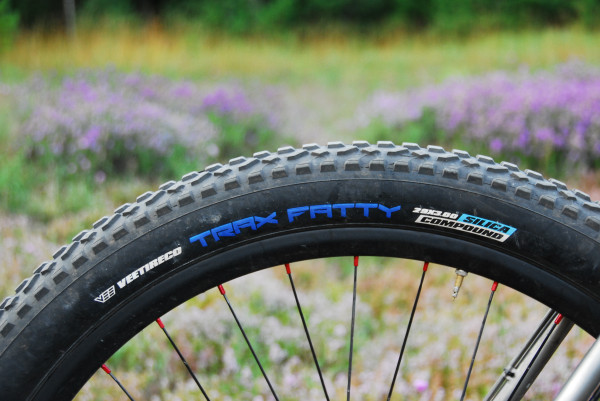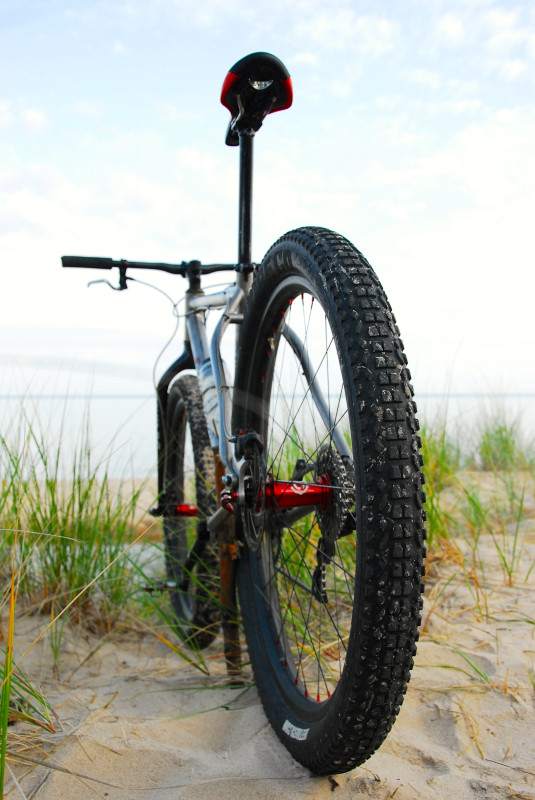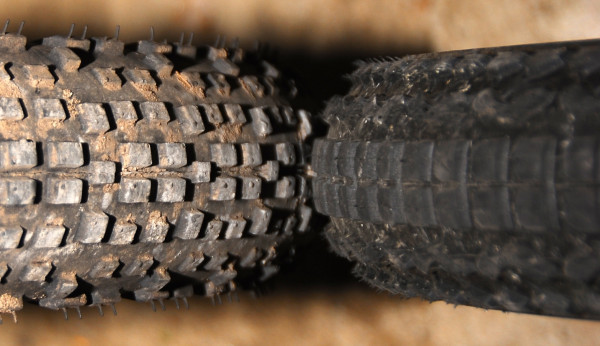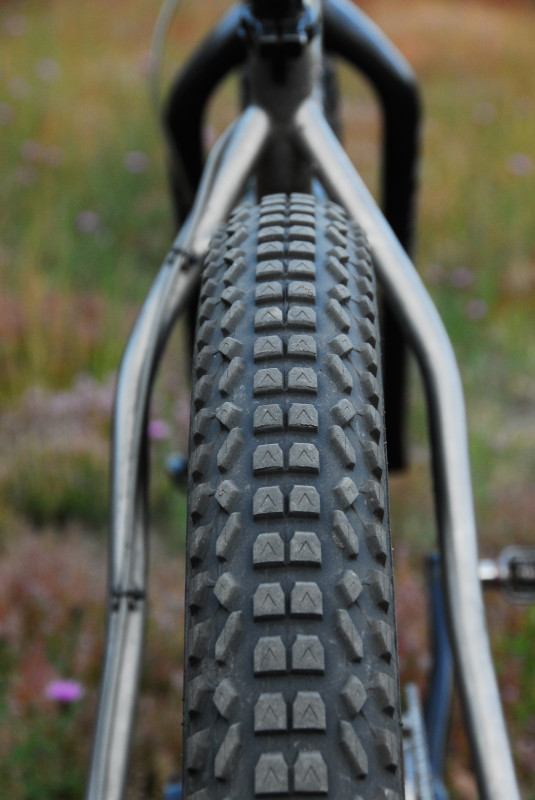About a month ago I got a package from Fat-Bike.com world headquarters with a pair of Vee Tire Trax Fatty 29 x 3.0” tires. This is the same pair that they took a First Look at back in April and that article contains all of the numbers for the TF. I say, ‘screw the numbers’, I got this pair to find out about the ride, so I mounted them up on my 35mm Light Bicycle carbon rims tubeless with 3 scoops of sealant and they popped right into place using a floor pump. With the exception of a hole in the tread area from a previous tester that sealed up quickly the whole tubeless process was as easy as any tire I have worked on (of any size). Good signs all around!
My first ride on them was one of those “choose your own adventure” rides where I took off with a lot of food and water, a National Forest Service road map, some aerial photography and a general idea of where I wanted to end up but no specific route or plan. The goal was to use the Lake Michigan shoreline and the least amount of road possible to access some old school ORV trails. These trails would link me up with Forest Service roads that would get me out to one of our local trail systems before reversing the process to get back home 5-6 hrs and 60-70 miles later. I purposely chose this ride because the diverse surface types I would hit along the way would give me a good idea of what this tire can do in a lot of different situations.
Even on my short ride on trail to the Lake Michigan shoreline I was amazed at how much faster the bike felt due to the half pound rotating weight I had lost switching from my knards. Beach conditions were ideal with low wind and wet sand from a good soaker rain the night before. After several miles on the beach I couldn’t tell any difference in float/sand performance between the Knard and Trax Fatty. Neither is as good as a 4” fat bike tire but they get the job done in all but the deepest beach sand.
I then hit the road for a couple miles and immediately noticed how fast the Trax Fatties rolls. The big blocks in the center of the tread roll with minimal noise and a sure feel on the road and hard pack dirt. They do exhibit a weird feeling though when cornering at speed. “Squirmy” is too harsh a description but there is a discernible transition when leaned over and you move from the big center blocks to the smaller and more sparse side knobs. The tires actually cornered well on hard pack/road but the feel was just a bit disconcerting initially. All in all “interesting” but positive.
Next up was the ORV trails which consists of loose two tracks, super sandy “test hills,” and mudder runs. Similar to riding along Lake Michigan, the sandy sections did more to confirm the overall versatility of the 29er+ then highlight any differences between the Knard and Trax Fatty. The mudder runs were what surprised me. By no means would I describe the Trax Fatty as a mud tire because the overall traction wasn’t great, but I was impressed with how little it clogged up and kept me rolling. Granted this was loamy mud, not a heavy clay mud but it cleared better than the Knards and allowed me to keep rolling through sticky mud.
After a lot of playing on the ORV trails I moseyed out to our local singletrack. The tires seemed to hook up well and I had a ball ripping around and roosting corners. That said, I could already tell it was going to be difficult to see if the absolute cornering traction was better or worse than the Knards. Nothing but a bunch more miles and also some racing on them was going to flesh out where the Trax Fatty stood in this regard.
Now seems to be the time to hit what is the elephant in the room with a lot of Vee Tires – the narrow tread. For a given casing size, most Vee Tires have considerably more narrow tread than other tire manufacturers. For example, on my 35mm rims the Trax Fatty has a 71mm casing width and 67mm wide knobs whereas the Knard is 72mm casing/76mm knob. If the narrow tread design is going to work on any setup, it is going to work on what I am running because the more narrow rim (35mm vs. 50mm Rabbit Hole) will make the casing more rounded and allow you to lean the bike over further before you run out of side knobs.
The first few times I really leaned the bike over hard in a corner with the Trax Fatties I was a bit worried about the tires hooking up because of the narrow tread but it was completely not an issue. My biggest beef with the Knards for our local trails is seriously lack of traction in the transitional zone from being more upright to leaned way over. The Trax Fatty didn’t exhibit any similar issues and had surprisingly good traction until you leaned it really far over. Up to about 45 degrees of lean angle the Trax Fatty seemed to have a bit better cornering traction than the Knard and if you push the bike over a bit more, the Knard seems to take the lead on cornering traction. Which tire wins out for you is really dependent on your style of riding and trail conditions.
I was curious how their silica rubber compound would hold up considering I have always heard that it aides winter traction. After about 400 miles of trail, asphalt and gravel the knobs are a bit more rounded and none of the knobs are missing chunks or ripped. I would rate the tread durability as better than average.
Overall I am impressed with the Trax Fatty. It has many similar characteristics to the Knard making it a fast rolling and versatile design. Tread wear seems to be a bit better than the Knard and the weight of the pair I tested gives the TF a definite edge while the Knard is the better tires for aggressive, high lean angle cornering. I am planning to run the Knard on the front and Trax Fatty on the rear for a while to leverage the strengths of each option. It is so nice to finally be able to use the word “option” when talking about 29er+ tires! Speaking of which, a pair of Maxxis Chronicle tires is headed my way for testing so stay tuned for how those stack up.
KBS Trax Fatty Rating: 4 out of 5 Pints!






Quick question… you running 27 or 120 knards? I was hoping to try something else but haven’t found any of these new tires available yet on the streets so I just ordered two more knards which I am pleased with overall.
I have been running the 120 tpi knards.
Interesting review! Good insight on these for sure. What did these come in weight wise because from what I have see of the 120 tpi Knards on here they seem to come in around 900 to 1000 g per tire and these are a 1/2 lb lighter? Is that per tire or the overall set. Either way more options is a good thing.
Also, not sure if I saw it but what rim you running at 35mm and Carbon and do you possibly think that the rim width was the contributing factor and being possibly too narrow for the tires and caused them to act funny like you experienced???
Great review!
My knards weigh in at over 100g per tire more than the Trax Fatties so that works out to about 0.45 lbs more for the Knards than the Trax Fatties – enough difference to really feel on the trail.
The 35/30mm rims (outer/inner dimensions) are proportionally still wider compared to 3″ tires than most “standard” MTB tires. For example, if you compare the ratio of a 2.25″ tire and 21mm inner width rim (like a Crest, ArchEX…) the tire is 2.7 times wider than the inner rim while these 3″ tires are only 2.5 times wider than the inner rim. Yeah, the rim width is a compromise but for me dropping a heck of a lot of weight, gaining really good tubeless compatibility and also having a super stiff rim is preferable compared to the current wider rim options.
All of that said, I do think that the 35mm rim width is a contributing factor to some of the weird cornering characteristics I have felt with the knards. They tend to be VERY tire pressure sensitive because you need to have them low enough pressure to flatten out on the ground to employ the tall knobs as you lean over in a corner but if you go too low the tire gets floppy on the narrow rim. I think I noted this in my fat-bike.com write-up about the Judas Goat. With the Trax Fatty I am guessing the narrow rims actually help because of their narrow tread. Luckily, the Maxxis Chronicle ups the cornering game a TON but that is a topic for an upcoming article.
Thanks Ken for the added insight! For me, I run my fat tires probably a bit higher pressure wise than most. I think that the slightly higher pressure helps alot with the weird steering that some of the tires seem to exhibit. I would say that I run at least 15 to 20 psi front and rear and I like them that way because of where I ride. Even with those higher pressures I still hear the rim and tire bottoming out from trail obstacles. I know that even at those pressures I am still getting the suspension from the tires. Winter snow is different with lower pressures for sure but in the other seasons, firmer is better IMHO! The tires just roll better. Gonna be building up some Rabbit Holes in the next couple of days with Knards and can’t wait to see how they feel. I think they are gonna be AWESOME!!!!! Looking forward to the article on the Maxxis Chronicle!
Ok- so my head is spinning… I have read most of your reviews and talked with Scott Q at Iceman. I am getting a new set of 29+ wheels for 2016 (I9 Torch/Dually). I live in TC and do lots of technical singletrack and sandy 2 track and will do some NUE Races in 2016 on these wheels… I ride for Framed Bikes and they sent me a tire they were testing that Innova is now putting out on their own… the Transformer. i love mine, but they’re wire bead 955g and I can’t get them tubeless… these are the tires I am considering- Fat B Nimble (worried about squirrely and thin side walls), Innova Pro Transformers in a Kevlar bead (not sure on weight 872g-920g is what I see, but limited data on the tire), Bontrager Chupacabra, Vee TraxFattie. I am 150lbs and more of a power rider and want sure traction for technical riding- my style/skill isn’t in drifting the corners. I wish you had the Innovas to compare, because my hunch is you’ve ridden all the others. Help me clear a path and pick a tire. You rock!
Check our our site plusbikes.com.
Steve,
Thanks for the kind words!
I haven’t run the Transformer but I have ridden a single Gravity which looks to be the same tread, just a wire bead version of the Transformer. Since I only had one of the Gravity tires it is kind of tough to really compare it to some of the other 29+ offering but… I was SUPER impressed with the tread design. It seems like a Racing Ralph but super sized – rolled pretty fast, cornered great, had very solid traction, shed mud pretty well – basicly a great all around tire that could compete with the best design out there. The knobs are a bit taller than the Chupacabra (probably my favorite all rounder 29+ tire) so the Gravity had a bit better traction in certain conditions.
I really like the Fat B Nimbles for Northern Michigan riding due to their low weight and ability to roll fast. That said, they fall behind the other options in traction and durability which could be a really big issue if any of the NUE races you plan to do are rocky. They also are not as good in mud as the Chupacabra so that is something else to consider for the spring NUE races like Mohican and Cohutta.
That really leaves the Chupacabra and the Transformer and both of those are really similar in weight and a lot of characteristics. The Gravity was surprisingly light for the wire bead and the sidewalls were really thin so that makes me a bit worried about durability (not sure how that transfers to the Transformer though) while the Chupacabra has proven pretty darned good on durability.
Sorry for nothing more definitive but hopefully the above helps!
Would you have access to the specs by any chance or a web site (same type of info specs as for the 29er tire you describe above). I can’t find it anywhere, I contacted vee rubber, no response.
Also trying to determine is it would work on a 32.2mm wide (outer) rim (alex dm24)
Any help appreciated, no retailers in my region.
Vee Tire 26×3.0 Traxx Fatty
XXmm? at the casing
XXmm? at the knobs
XXXmm? diameter
thanks much
I think all the tire dimension data you want is on the “First Look” posting linked in the 2nd sentence of this posting: https://fat-bike.com/2014/04/first-look-vee-tire-traxx-fatty-29-tire/
In theory the dm24 could work if you keep the pressure high enough but that narrow of rim is definitely not ideal. The inner width is only 24mm on that rim and I wouldn’t recommend going narrower than around 30mm inner width for that size of tire.
thanks i read that article but i am looking for 26 not 29 in
however do you think the widths would be virtually identical for 26in.
but i need have the diameter though for 26 or do you think subtracting 3 inches would be close enough to estimate the height
Sorry about not reading your question more carefully and catching the 26er part. I think if you check out this forum on MTBR there is discussion about the dimensions of the tire: http://forums.mtbr.com/26-27-5-29-plus-bikes/26-3-0-vee-trax-fatty-991791.html I don’t see any info about the diameter listed anywhere but they do have the width listed for the tire on a 47mm rim.
Subtracting 3″ will get you VERY broadly in the ballpark of the diameter but I am guessing that won’t be accurate enough to offer much certainty that it will fit in your bike. You may be better off grabbing dimensions off published pics of the tire and doing some math to approximate the true diameter. That can be fraught with error too but if you are careful can also lead to some solid numbers for situations like this where a new product comes out and you don’t have a lot of info on it.